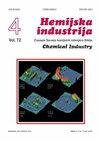用恒电流制备的铜粉填充聚乳酸和聚3-羟基丁酸复合材料的电导率
IF 0.8
4区 工程技术
Q4 ENGINEERING, CHEMICAL
引用次数: 3
摘要
本文介绍了以高枝晶结构的聚乳酸(PLLA)和聚3-羟基丁酸酯(PHB)为基体填充电铜粉的复合材料的实验研究。所制备的复合材料中作为填料的铜粉的体积分数在0.5 ~ 6.0 vol.%范围内变化。样品在170℃下进行热成型注射。考察了颗粒大小、形貌以及基体类型对复合材料电导率和渗透阈值的影响。表征包括:电导率测量使用交流阻抗谱(IS),扫描电子显微镜(SEM),能量色散x射线光谱(EDS)和傅里叶变换红外光谱(FTIR)。三维导电通路的存在得到了证实。测得PLLA和PHB复合材料的渗透阈值分别为2.83 vol.%和3.13 vol.%,比文献中类似复合材料的渗透阈值低约3倍。这种性质是由于在本研究中使用的填料的不同形态。本文章由计算机程序翻译,如有差异,请以英文原文为准。
Electrical conductivity of poly (L lactic acid) and poly (3-hydroxybutyrate) composites filled with galvanostatically produced copper powder
This manuscript presents experimental studies of composite materials based on poly (L lactic acid) (PLLA) and poly (3-hydroxybutyrate) (PHB) matrices filled with electrolytic copper powder, having a very high dendritic structure. Volume fractions of the copper powder used as filler in all prepared composites were varied in the range 0.5-6.0 vol.%. Samples were prepared by hot moulding injection at 170 °C. Influence of particle size and morphology, as well as the influence of matrix type on conductivity and percolation threshold of the obtained composites were examined. Characterization included: electrical conductivity measurements using AC impedance spectroscopy (IS), scanning electron microscopy (SEM), energy-dispersive X-ray spectroscopy (EDS) and Fourier-transform Infrared spectroscopy (FTIR). Presence of three-dimensional conductive pathways was confirmed. The obtained percolation thresholds of 2.83 vol.% for PLLA and 3.13 vol.% for PHB composites were measured, which is about three times lower than the ones stated in the literature for similar composites. This property is ascribed to different morphologies of the filler used in the present investigation.
求助全文
通过发布文献求助,成功后即可免费获取论文全文。
去求助
来源期刊

Hemijska Industrija
工程技术-工程:化工
CiteScore
1.60
自引率
11.10%
发文量
12
审稿时长
6-12 weeks
期刊介绍:
The Journal Hemijska industrija (abbreviation Hem. Ind.) is publishing papers in the field of Chemical Engineering (Transport phenomena; Process Modeling, Simulation and Optimization; Thermodynamics; Separation Processes; Reactor Engineering; Electrochemical Engineering; Petrochemical Engineering), Biochemical Engineering (Bioreactors; Protein Engineering; Kinetics of Bioprocesses), Engineering of Materials (Polymers; Metal materials; Non-metal materials; Biomaterials), Environmental Engineeringand Applied Chemistry. The journal is published bimonthly by the Association of Chemical Engineers of Serbia (a member of EFCE - European Federation of Chemical Engineering). In addition to professional articles of importance to industry, scientific research papers are published, not only from our country but from all over the world. It also contains topics such as business news, science and technology news, information on new apparatus and equipment, and articles on environmental protection.
 求助内容:
求助内容: 应助结果提醒方式:
应助结果提醒方式:


